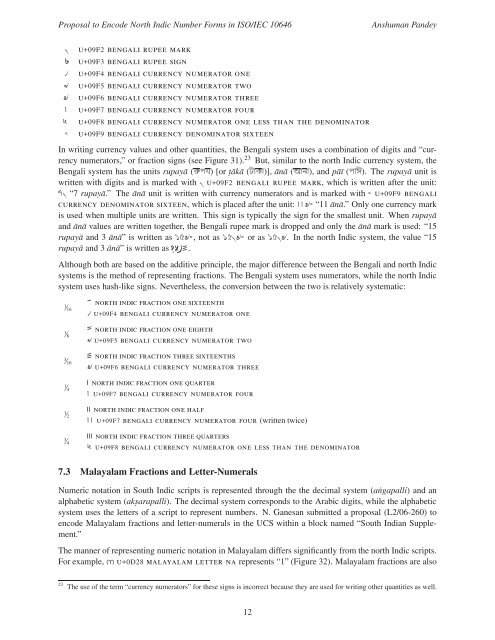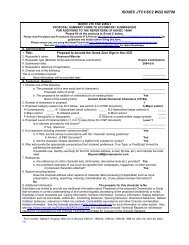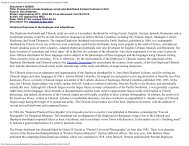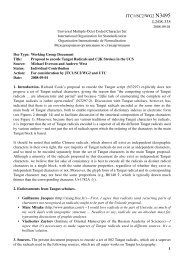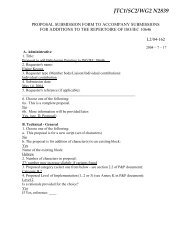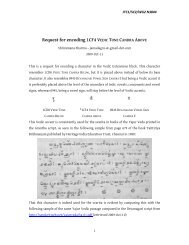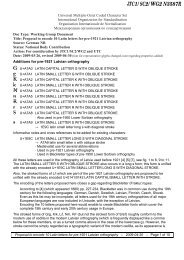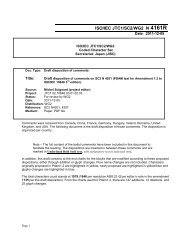Common Indic Number Forms - dkuug
Common Indic Number Forms - dkuug
Common Indic Number Forms - dkuug
You also want an ePaper? Increase the reach of your titles
YUMPU automatically turns print PDFs into web optimized ePapers that Google loves.
Proposal to Encode North <strong>Indic</strong> <strong>Number</strong> <strong>Forms</strong> in ISO/IEC 10646 Anshuman Pandey<br />
u+09F2 bengali rupee mark<br />
u+09F3 bengali rupee sign<br />
u+09F4 bengali currency numerator one<br />
u+09F5 bengali currency numerator two<br />
u+09F6 bengali currency numerator three<br />
u+09F7 bengali currency numerator four<br />
u+09F8 bengali currency numerator one less than the denominator<br />
u+09F9 bengali currency denominator sixteen<br />
In writing currency values and other quantities, the Bengali system uses a combination of digits and “currency<br />
numerators,” or fraction signs (see Figure 31). 23 But, similar to the north <strong>Indic</strong> currency system, the<br />
Bengali system has the units rupayā (Ô) [or t.ākā (Ì)], ānā (Ò), and pāī (Ô£). The rupayā unit is<br />
written with digits and is marked withu+09F2 bengali rupee mark, which is written after the unit:<br />
“7 rupayā.” The ānā unit is written with currency numerators and is marked withu+09F9 bengali<br />
currency denominator sixteen, which is placed after the unit: “11 ānā.” Only one currency mark<br />
is used when multiple units are written. This sign is typically the sign for the smallest unit. When rupayā<br />
and ānā values are written together, the Bengali rupee mark is dropped and only the ānā mark is used: “15<br />
rupayā and 3 ānā” is written as, not as or as. In the north <strong>Indic</strong> system, the value “15<br />
rupayā and 3 ānā” is written as15îâ.<br />
Although both are based on the additive principle, the major difference between the Bengali and north <strong>Indic</strong><br />
systems is the method of representing fractions. The Bengali system uses numerators, while the north <strong>Indic</strong><br />
system uses hash-like signs. Nevertheless, the conversion between the two is relatively systematic:<br />
1 ⁄16<br />
1 ⁄8<br />
3 ⁄16<br />
1 ⁄4<br />
1 ⁄2<br />
3 ⁄4<br />
à north indic fraction one sixteenth<br />
u+09F4 bengali currency numerator one<br />
á north indic fraction one eighth<br />
u+09F5 bengali currency numerator two<br />
â north indic fraction three sixteenths<br />
u+09F6 bengali currency numerator three<br />
ã north indic fraction one quarter<br />
u+09F7 bengali currency numerator four<br />
ä north indic fraction one half<br />
u+09F7 bengali currency numerator four (written twice)<br />
å north indic fraction three quarters<br />
u+09F8 bengali currency numerator one less than the denominator<br />
7.3 Malayalam Fractions and Letter-Numerals<br />
Numeric notation in South <strong>Indic</strong> scripts is represented through the the decimal system (a˙ngapalli) and an<br />
alphabetic system (aks. arapalli). The decimal system corresponds to the Arabic digits, while the alphabetic<br />
system uses the letters of a script to represent numbers. N. Ganesan submitted a proposal (L2/06-260) to<br />
encode Malayalam fractions and letter-numerals in the UCS within a block named “South Indian Supplement.”<br />
The manner of representing numeric notation in Malayalam differs significantly from the north <strong>Indic</strong> scripts.<br />
For example,u+0D28 malayalam letter na represents “1” (Figure 32). Malayalam fractions are also<br />
23 The use of the term “currency numerators” for these signs is incorrect because they are used for writing other quantities as well.<br />
12


